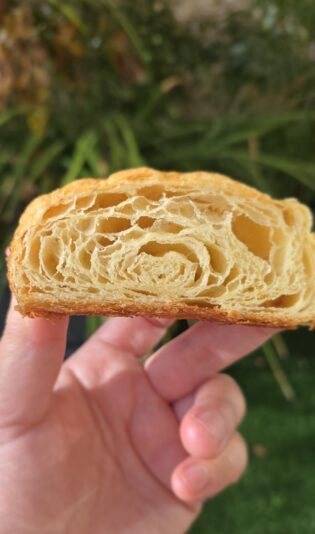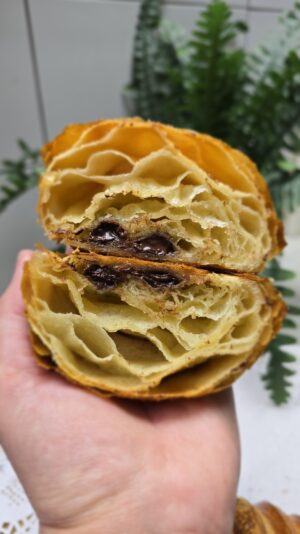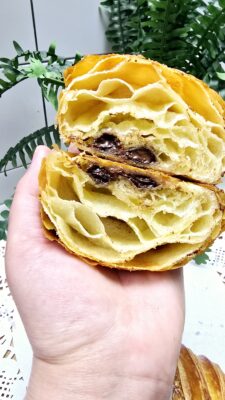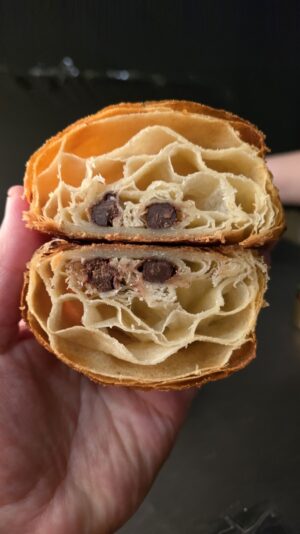Scoolinary › Forums › Ask a question › Croissants dough, Antonio's course
-
Croissants dough, Antonio's course
Posted by רות בביוף on February 4, 2025 at 13:42Hi,
I’d like to know why doesn’t the lower part
raise.
It happened a few times, even if I decreased the temperature.
Also I’d like to know where to place the tray in the oven.
Thanks
Ruthi Babayof
do
Sussan Estela Olaya replied 9 months, 3 weeks ago 2 Members · 17 Replies -
17 Replies
-
Level:
Scoolinary Team
Hi רות בביוף
Welcome to the Scoolinary community! Thank you for your question.
Your croissants have beautiful layers and a well-developed structure. It’s clear that you worked carefully on the lamination, and the crumb looks airy with a good distribution of alveoli.
As for the bottom not rising as much, this could be due to several factors. Have you tried adjusting the initial oven temperature? Sometimes starting with a higher heat and then lowering it helps activate the rise better. The position of the tray also plays a role; ideally, bake them in the center of the oven.
If the issue persists even after adjusting the temperature, it could be related to fermentation. Do you notice the base feeling denser before baking? It might be helpful to ensure the croissants have enough space to expand on the tray.
Your technique is excellent, and with a few minor adjustments, you’ll achieve an even more spectacular result. Have you considered experimenting with different types of flour to compare results?
Best regards.
-
Hi dear,
Thanks for your quick response!
I tried increasing the temperature at the beginning, but it was worse.
All the bottom wasn’t baked enough.
In regards to fermentation,
they had enough space in the oven.
I did bake them in the middle of the oven.
And this flour gave me the best results.
I really don’t know what to do…
Any other idea?
Must say that outside they look OK
The only thing I though is maybe after rolling them I press a little hard,actually it’s not so clear in the video, whether I have to leave them like this,or to press a little bit in the middle so that they will stay stable.
Waiting for your response .
Thanks 😊
-
-
Level:
Scoolinary Team
Hi רות בביוף
It’s great that your croissants look good on the outside! That means you already have a solid technique in many aspects of the process—what a great achievement!
The baking issue could be due to several factors, and I love how carefully you’re analyzing each step. Your observation about the pressure when rolling is very interesting. If you press too hard in the center, you might compact the dough, making it harder for it to expand properly in the oven, which could affect the baking of the bottom.
You could try adjusting the pressure when rolling them. I’m sure that with a few small tweaks, you’ll achieve an even better result!
Best regards.
-
-
Level:
Scoolinary Team
Hi
It looks like the issue with the bottom of your pain au chocolat could be related to how the dough is sealed or how the gluten develops in the lower layers. Here are a few things that might help:
1. Ensure a proper seal: Lightly press the bottom edges when placing the chocolate and rolling to help them stick.
2. Avoid loose rolling: If the dough is too loose when rolled, the bottom may not adhere properly.
3. Watch fermentation times: Overproofing can weaken the structure, making it harder for the pastry to hold its shape in the oven.
4. Strong initial heat: Start baking at a high temperature to help set the base before the butter melts too much.
Making croissants and viennoiserie takes a lot of practice. It’s completely normal for it to take time to perfect the technique, but with every attempt, you get closer to the ideal result. Keep practicing, and you’ll achieve the product you’re looking for soon!
Best regards
-
Thanks for your help!
What do you call high temperature at the beginning of baking?
Also,yesterday I made a batch of dough, laminate it with butter, but instead of putting it to rest for an hour, I left it for the whole night, because I was too tired.
Now my question is how to roll it, as it’s too cold,
Also,do you think that it will affect the results?
Thanks for your patience!
-
Level:
Scoolinary Team
Hi רות בביוף
I’m glad to hear you’re still making croissants!
The high temperature at the start of baking is called the “heat shock” or “thermal shock baking.” This step is crucial for the dough to expand properly and achieve that airy, flaky lamination.
Regarding the dough you left to rest overnight, it’s not a big issue, but since it’s very cold, it may become harder and more difficult to handle. To roll it out without breaking it, you can let it sit at room temperature for a few minutes until it becomes more flexible—just be careful not to let the butter soften too much.
As for the final results, it depends on how cold it got. If the butter crystallized too much, it could affect the texture, making the lamination less even. However, if the dough is still in good condition, you can proceed with shaping and proofing—just make sure it rises properly before baking.
I hope this helps!
Best regards.
-
Dear Sussan,
Your advice is worth gold!
If the recommended temperature is 170 so what will be high temperature?
And what does it mean the butter crystallized?
How does it look.
Thanks 😊 e
-
Level:
Scoolinary Team
Hi רות בביוף
If the recommended baking temperature by Chef Bachour is 170°C, then a higher temperature would be anything above that, such as 180°C or 185°C.
To ensure that the internal oven temperature is accurate, you can use an internal oven thermometer as a suggestion. This will help you verify that the temperature you are baking with is correct. If your oven has a built-in thermostat by default or from the manufacturer, it’s still a good idea to use an additional internal thermometer to confirm that it is reaching the correct temperature.
On the other hand, when butter is said to crystallize, it means that its fats have formed large crystals due to excessive cooling. This happens when butter stays at very low temperatures for too long, such as in the refrigerator or freezer.
In the case of croissants, if the butter inside the dough crystallizes too much:
-It can become brittle instead of flexible, making lamination more difficult.
-It can break into pieces instead of spreading into thin layers within the dough.
-When baked, the layer structure may not develop properly, resulting in a less airy and uniform texture.
To avoid this, if you notice that the dough is too hard and the butter seems brittle, it’s best to let it sit at room temperature for a few minutes before working with it.
I hope this information is helpful.
Best regards.
-
Thanks for your helpful advice!
Regarding to the dough,if I leave it in the fridge, after it was in the freezer, before laminating.
Instead of 1 hour,I left it for the whole night and then rolled it it and put it back in the freezer before baking.
Is that ok?
-
Level:
Scoolinary Team
Hi רות בביוף
The method you’re practicing has both advantages and disadvantages. Leaving the dough in the refrigerator overnight after freezing can work if you manage the time and temperature well, but it may also have negative effects depending on several factors. Here’s a breakdown:
Advantages of refrigerating overnight
1. Controlled fermentation: The dough can ferment slowly, which enhances the flavor.
2. Easier to laminate: The dough may be more relaxed and manageable the next day if it doesn’t become too firm in the refrigerator.
Potential issues
1. Overfermentation: If your dough contains active yeast and spends too many hours in the refrigerator, it may overferment, affecting the lamination and structure.
2. Changes in butter texture: During prolonged resting, the butter can harden or seep into the dough if not properly encapsulated, making the lamination process more difficult.
3. Layer degradation: If the dough spends too much time in the refrigerator before baking, the layers may begin to fuse, losing the flakiness.
Recommendations for your method
1. Check the fermentation: If your dough hasn’t grown too much overnight in the refrigerator, it should be fine to laminate and bake.
2. Monitor the freezing time: If you refreeze the dough before baking, make sure it’s only for a short period (maximum 20–30 minutes) to avoid hardening the dough or butter too much.
3. Test the results: If the flaky layers are present and the croissants turn out well when baked, your method is valid. If you notice a loss of flakiness or structural issues, it’s better to limit the resting time to 1–2 hours in the refrigerator.
Best regards.
-
Level:
Scoolinary Team
Hi רות בביוף.
Great! We’re here to help.
Best regards. 🙂
-
One more questions please….
If I take the croissants out of the freezer, Do I have to put put it an hour in the fridge first before proofing?
Thanks 😊
-
Level:
Scoolinary Team
Hi רות בביוף
Yes, it is recommended. If you take the croissants out of the freezer, letting them rest in the refrigerator for an hour before proofing helps them gradually come up to temperature. This prevents the butter from melting too quickly and preserves the structure of the layers.
After that, you can let them proof at room temperature until they double in size.
Best regards.
-
-
Level:
Scoolinary Team
Hi רות בביוף
The issue of an open base in croissants can be caused by several factors:
1. Insufficient fermentation → If the dough doesn’t fully ferment, the croissants won’t have enough strength to hold their structure.
2. Oven too hot → If the heat is too strong from the start, the outer layer solidifies too quickly, preventing even expansion.
3. Irregular folding or lamination → If the butter isn’t distributed properly, separation at the base can occur.
Solution
Ensure full fermentation: the croissant should jiggle slightly when you move the tray.
Place the tray in the lower third of the oven so the base receives enough heat without burning.
You’re on the right track! Mastering croissants takes practice. I recommend taking notes every time you bake them to track your process, compare batches, and identify what adjustments lead to better results.
With small tweaks, you’ll achieve a better structure.
Best regards!
-
-
-
-
-
The forum ‘Ask a question’ is closed to new discussions and replies.









